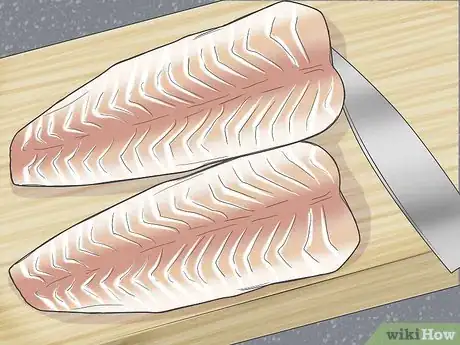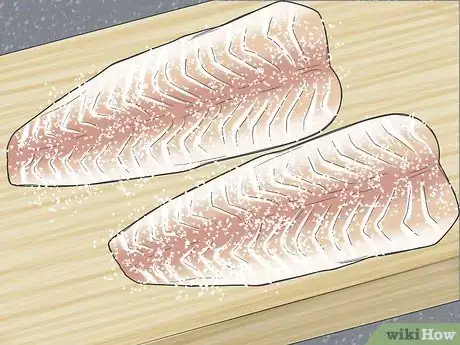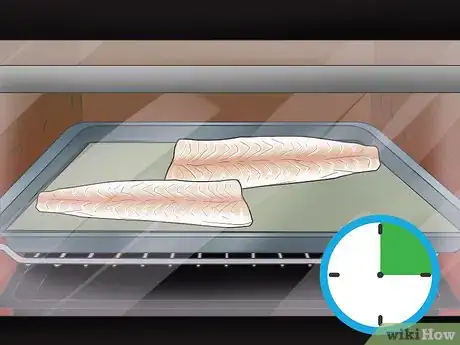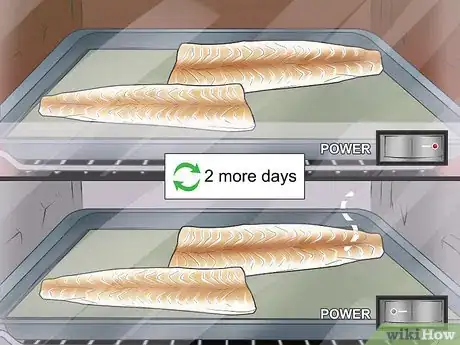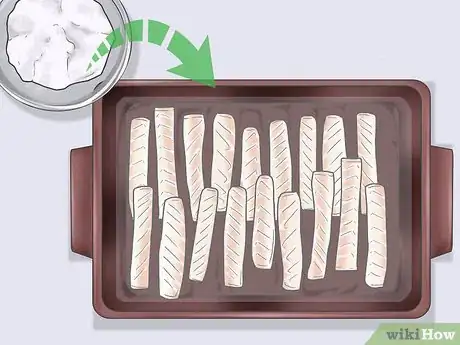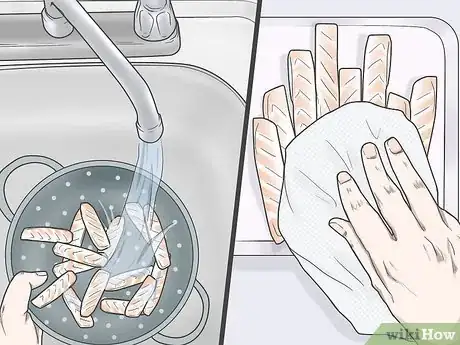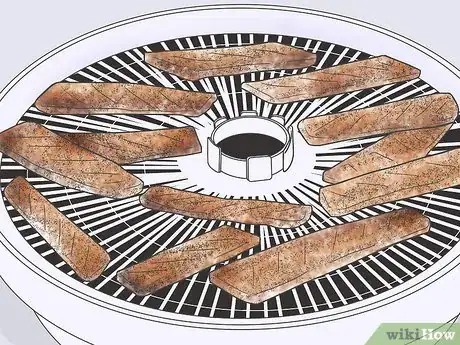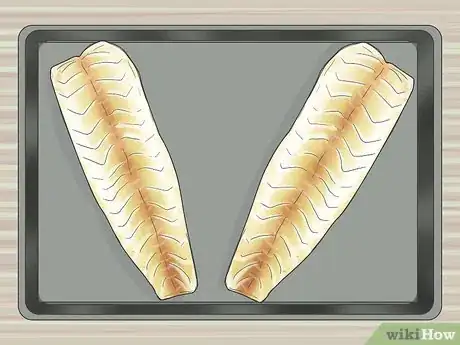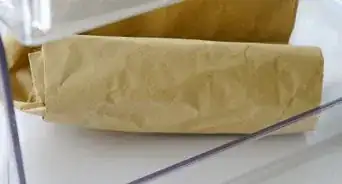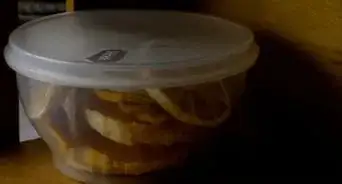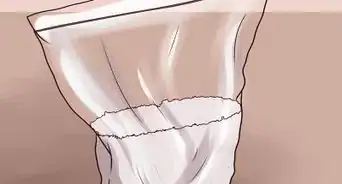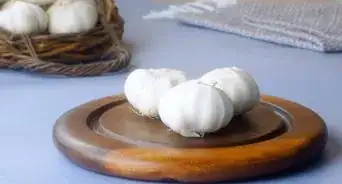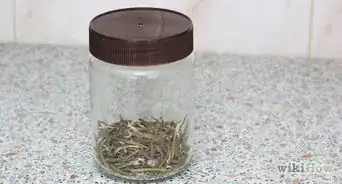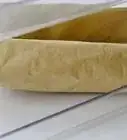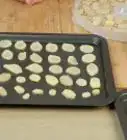This article was co-authored by wikiHow Staff. Our trained team of editors and researchers validate articles for accuracy and comprehensiveness. wikiHow's Content Management Team carefully monitors the work from our editorial staff to ensure that each article is backed by trusted research and meets our high quality standards.
There are 9 references cited in this article, which can be found at the bottom of the page.
This article has been viewed 59,784 times.
Learn more...
Drying fish is a great way to preserve your fresh catch over the coming weeks and months. The drying process removes moisture from the fish which means that it takes longer to spoil. You can use either an oven or a dehydrator to dry fish. The fish can be dried either whole or in smaller strips. When choosing fish to dry, choose a type that isn't fatty, make sure that it is fresh, and then begin the drying process as quickly as possible.
Steps
Using an Oven
-
1Preheat the oven to 180 °C (356 °F). Turn the oven on, and wait for it to heat up to the required temperature. Many ovens will have a small light or switch that indicates when the set temperature is reached, but if not, waiting for approximately 15 minutes will do.[1]
- If you are using a fan-forced oven setting rather than a conventional setting, reduce the temperature by 20 °C (68 °F).
-
2Clean the fish by removing the innards and the skin. Use a sharp knife to cut along the belly of the fish until you reach the head. Scoop out all of the innards using a spoon, and discard these. Rinse out the cavity, scrape off the skin, and run the fish under cool water.[2]
- You only need to clean the fish if you are have purchased or caught a whole fish to dry. If you prefer, you can ask your local fishmonger to clean and fillet the fish for you, so that you can dry it in smaller pieces.
Advertisement -
3
-
4Cook the fish in the oven for 15 minutes. Place the fish on an oven tray, and leave it in the oven with the door closed. Set a timer for 15 minutes.[5]
-
5Turn the oven off and leave the fish in the oven for 1 day. When the timer goes off, turn off the oven, but leave the fish resting on the oven tray. Keep the oven door closed.[6]
-
6Repeat the cooking and drying process for 2 more days. In 24 hours time, preheat the oven and cook the fish for 15 minutes again, before switching the oven off. Repeat this process on the third day, and then remove the fish from the oven after the final drying session.[7]
- Keep the fish in the oven for the entire 3 days, including while the oven is preheating. This means that you cannot cook using the oven during this time.
-
7
Using a Dehydrator
-
1Clean the fish and remove the skin. Remove the skin or scales of the fish using a dull knife. Remove the innards of the fish, and rinse the body inside and out thoroughly.[10]
- You only need to clean the fish if you have purchased or caught a whole fish. If possible, ask your local fishmonger to fillet the fish, or slice it into thin strips for you.
-
2Slice the fish into 0.375 in (0.95 cm) thick strips. Make sure that all of the pieces are similar in size, as this ensures that they will dehydrate evenly. Remove any bones as you come across them.[11]
-
3Marinate the fish pieces for 30 minutes in a salt water brine. Combine ¾ cup (205 g) of salt and 1 ½ quarts (1.42 L) of cold water in a large dish. Place the pieces of fish into the brine, and let them marinate for 30 minutes.[12]
-
4Rinse off and dry the fish pieces. Drain away the brine from the fish pieces. Run the strips under cool, running water to wash the salt away thoroughly. Use a paper towel to pat each piece dry.[13]
-
5Season and store the fish strips in the refrigerator for 6 hours. Place the fish pieces into a plastic or glass airtight container. Add salt or your favorite seasoning to the fish.[14]
- Some fish seasonings to try include pepper, paprika, oregano, or garlic powder.[15]
- Refrigeration at this point is necessary because it helps the dry cure to set in the fish.
-
6Place the fish strips in the dehydrator for 8-12 hours at 145 °F (63 °C). Place the fish strips on the dehydrator trays. Make sure that the pieces aren't touching each other.[16]
- Test when the fish strips are ready by checking that there is no visual moisture, that the strips do not crumble when they are squeezed, and that they smell fishy.
-
7Store the dried fish strips in a cool, dark place for up to 2 months. Place the fish pieces into vacuum sealed jars, or into zip lock plastic bags. A pantry is an ideal location to store the dried fish.[17]
- If you want to increase the shelf life of the dried fish pieces, place the pieces into the freezer for up to 6 months.[18]
Choosing Fish to Dry
-
1Choose fish that is fresh with bright and shiny skin. Check that the eyes are clear and not cloudy, as this indicates that the fish has been freshly caught. There shouldn't be an overly fishy smell.[19]
- Avoid fish that have dull, dry, or loose scales.
-
2Avoid choosing fatty fish as it will spoil faster. Fish that is low in fat will keep for longer when dried. Try cod, flounder, snapper, or sole.[20]
- Fatty types of fish include catfish, salmon, and shark.
- Any type of fish can be dried, however the lighter it is, the longer it will last.
-
3Dry the fish as quickly as possible. When you catch or purchase fresh fish, start the drying process as soon as possible to keep it fresh. This will avoid spoilage, and the dried fish will taste better.[21]
- Don't dry frozen fish, as the quality of the dried product won't be as good.
Warnings
- Regularly check your dried fish for signs of spoilage. Don't consume the dried fish if it smells overly fishy, looks moist, or if it appears slimy.[22]⧼thumbs_response⧽
Things You'll Need
Using an Oven
- Knife
- Spoon
- Oven tray
- Airtight container
Using a Dehydrator
- Knife
- Spoon
- Large dish
- Paper towels
- Airtight container
References
- ↑ https://www.sbs.com.au/food/recipes/dried-fish-liberian-style
- ↑ https://www.takemefishing.org/how-to-fish/how-to-catch-fish/how-to-clean-a-fish/
- ↑ https://www.sbs.com.au/food/recipes/dried-fish-liberian-style
- ↑ https://honest-food.net/how-to-smoke-salmon-recipe/
- ↑ https://www.sbs.com.au/food/recipes/dried-fish-liberian-style
- ↑ https://www.sbs.com.au/food/recipes/dried-fish-liberian-style
- ↑ https://www.sbs.com.au/food/recipes/dried-fish-liberian-style
- ↑ https://www.sbs.com.au/food/recipes/dried-fish-liberian-style
- ↑ https://food.unl.edu/food-storage-chart-cupboardpantry-refrigerator-and-freezer
- ↑ https://www.trail.recipes/dehydrating123/dehydrating123-how-to-dehydrate-fish-and-seafood-for-backpacking-meals/
- ↑ http://www.dehydratorbook.com/fish-jerky.html
- ↑ http://www.dehydratorbook.com/fish-jerky.html
- ↑ http://www.dehydratorbook.com/fish-jerky.html
- ↑ http://www.dehydratorbook.com/fish-jerky.html
- ↑ https://thehealthyfish.com/easy-spice-rubs-for-fish/
- ↑ http://www.dehydratorbook.com/fish-jerky.html
- ↑ https://www.trail.recipes/dehydrating123/dehydrating123-how-to-dehydrate-fish-and-seafood-for-backpacking-meals/
- ↑ https://www.eatbydate.com/proteins/seafood/fish-shelf-life-expiration-date/
- ↑ http://dish.allrecipes.com/how-to-choose-fresh-fish/
- ↑ http://www.dehydratorbook.com/fish-jerky.html
- ↑ http://www.dehydratorbook.com/fish-jerky.html
- ↑ https://www.eatbydate.com/proteins/seafood/fish-shelf-life-expiration-date/

